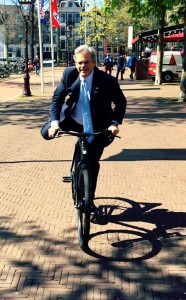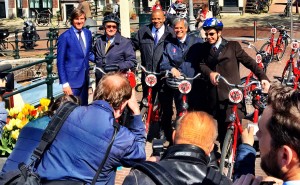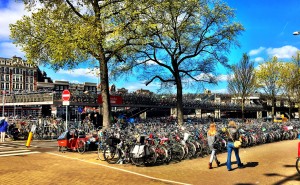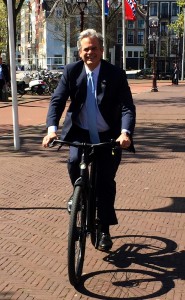 By Steve Adler
By Steve Adler
Our innovation exchange trip with Transportation Secretary Anthony Foxx just took us through Amsterdam where we met with Dutch Mayors, non-profits (NGOs), and companies all in pursuit of the “Smart City” vision. What Diane Land, my wife, Rob Spillar, the director of our city’s transportation department, have seen is interesting and has potentially interesting applications to our mobility challenges in Austin.
First off, a Smart City is a city in which data is captured from all aspects of urban life and then that data is employed to improve its residents’ quality of life. This could take a thousand different forms, such as traffic lights that monitor traffic levels and patterns, time of day, weather, events in the area, and then which adjust synching and timing to minimize traffic delay. In other words, the kind of thing we’re working on with the Smart City Challenge.
And of course I need to explain this picture, but more on that below.
But it could also be monitori ng who is traveling from where to where and by what mode of transportation to learn patterns and tendencies that could be used to set transit routes and frequencies or to identify which road projects would have the greatest beneficial community impact. In other words, we get smarter.
ng who is traveling from where to where and by what mode of transportation to learn patterns and tendencies that could be used to set transit routes and frequencies or to identify which road projects would have the greatest beneficial community impact. In other words, we get smarter.
It could also be cars talking to other cars, or back and forth with bikes, and each talking to traffic lights and sensors so that we all know how to avoid collisions and where to find open parking spaces.
It’s about cities capturing big amounts of data and making that data “anonymized” and then publicly and openly available for everyone, including start-ups and entrepreneurs, to figure out how to employ that big data in ways that make our lives better.
It’s a thousand different things — limited only by our imagination.
And it’s real. Folks are working on this today.
Here in Amsterdam we are “speed dating.” I’ve been able to sit and visit with dozens of entrepreneurs about our challenges in Austin and to learn of their technologies and solutions to see what fits (including but not limited to TomTom, Eindhoven, TU/e, AMS-Institute, TUDelft, Coast to Coast e-Mobility, and VanMoof). Some of the matches may show up in our Smart City $50 million challenge application.
Side note: I really enjoyed the opportunity to meet with the international Executive VP and CEO of NXP, Guido Dierick, based in the Netherlands. I was so impressed with how much he knew about Austin and how their office (formerly Freescale) has continued to be such a valuable corporate citizen in our town.
 It’s great to be in a city where it’s so easy for so many people to move about easily. Again, this is a city that was autocentric up until the mid-‘70s. Then one year, several hundred children were killed trying to ride their bikes on city streets. The response was to create an inventory of bike trails that were separated from car traffic and safe for riders, much like we are working on now in Austin. That advance in safety led to an explosion of new bike riders – folks riding to and from work, clinics, shopping – everything. This picture is of a bicycle garage in Amsterdam. Note the second deck.
It’s great to be in a city where it’s so easy for so many people to move about easily. Again, this is a city that was autocentric up until the mid-‘70s. Then one year, several hundred children were killed trying to ride their bikes on city streets. The response was to create an inventory of bike trails that were separated from car traffic and safe for riders, much like we are working on now in Austin. That advance in safety led to an explosion of new bike riders – folks riding to and from work, clinics, shopping – everything. This picture is of a bicycle garage in Amsterdam. Note the second deck.
The really fun part of this city? Riding an electric bike! That’s what I’m doing in the photograph above. Imagine a regular bike where each pedal of the bike comes so easily, like power steering for the pedals. This is not a motorcycle or a moped. It’s just assisted pedaling. These  would be perfect in Austin where folks need to negotiate hills. It also means that someone on an electric bike in Austin on a hot day would not be exerting themselves. And it’s pretty fun! (We’re going to reach out to B-Cycle to see if some of those bikes could be electric.)
would be perfect in Austin where folks need to negotiate hills. It also means that someone on an electric bike in Austin on a hot day would not be exerting themselves. And it’s pretty fun! (We’re going to reach out to B-Cycle to see if some of those bikes could be electric.)
Most people aren’t going to get out of their cars anytime soon in Austin. But no significant number ever will be ready to get out of their cars unless or until there are alternatives. We have work to do in Austin, and I was glad to see that it can work in Amsterdam.
P.S. — Also, just a reminder, but Diane and I are going dutch in the Netherlands. My travel expenses are being covered by the Smart City Challenge finalist funds provided by the U.S. Department of Transportation, and she’s paying for herself out of our private funds.
P.S. #2 — If you want to know why I’m putting my back into the Smart City Challenge and why, win or lose, we need to use technology to transform our city’s mobility capabilities regardless, then you really need to read Amy Kamp’s latest piece in the Austin Chronicle. The Smart City Challenge is a mobility initiative that helps with affordability, too.
